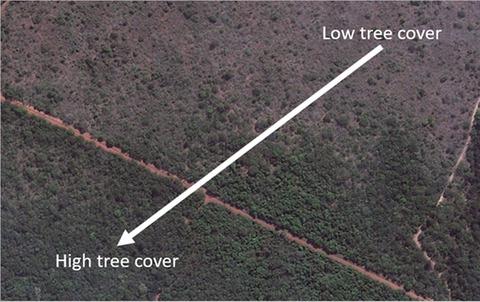当前位置:
X-MOL 学术
›
Funct. Ecol.
›
论文详情
Our official English website, www.x-mol.net, welcomes your
feedback! (Note: you will need to create a separate account there.)
Savannas are not old fields: Functional trajectories of forest expansion in a fire-suppressed Brazilian savanna are driven by habitat generalists
Functional Ecology ( IF 4.6 ) Pub Date : 2021-05-03 , DOI: 10.1111/1365-2435.13818 Samuel W. Flake 1 , Rodolfo C.R. Abreu 1, 2 , Giselda Durigan 3 , William A. Hoffmann 1
中文翻译:

热带稀树草原不是古老的领域:在受火抑制的巴西稀树草原中,森林扩张的功能轨迹是由栖息地通才驱动的
更新日期:2021-05-03
Functional Ecology ( IF 4.6 ) Pub Date : 2021-05-03 , DOI: 10.1111/1365-2435.13818 Samuel W. Flake 1 , Rodolfo C.R. Abreu 1, 2 , Giselda Durigan 3 , William A. Hoffmann 1
Affiliation

|
- Under fire suppression, many tropical savannas transform into forests. Forest expansion entails changes in environmental variables and plant community structure. We hypothesized that forest expansion into savanna results in a shift in community-weighted mean functional traits from stress tolerance to competitiveness, with generalist species having trait values intermediate between those of specialists of savanna and forest habitats.
- We studied 30 plots distributed over three savanna–forest boundaries undergoing forest expansion in the Brazilian Cerrado, capturing a gradient from open savanna to recently formed forest. We measured functional traits of 116 woody species of savanna specialist, generalist and forest specialist functional groups and quantified changes in species composition and mean traits across the basal area gradient.
- We identified two main axes of species traits. The first separated forest and generalist species from savanna specialists, with the latter possessing traits associated with resistance to disturbance and stress— such as thick leaves, thick bark, slower height growth and lower shade tolerance. Our second trait axis separated shrubs and understorey trees from pioneer species. Generalist species’ traits did not differ substantially from forest species, nor did they tend to have a typical pioneer strategy.
- Community-weighted trait means changed linearly with forest development. There was a steady increase in traits associated with competitive dominance rather than stress tolerance and fire resistance, indicating a wholesale shift in the selective environment. Several of these patterns—for example, increasing height and decreasing light requirements—are common in old-field succession. In contrast to old-field succession, we found that SLA increased, leaf thickness decreased and wood density stayed constant.
- The assembly of forests appears to be shaped by environmental filters that contribute to a functional trajectory distinct from most other studied ecosystems. Our results highlight the importance of the functional composition of the early community and of the early colonizers of the open environment. Differences between savanna and forest specialists reflect the selective effects of the contrasting environments, while the traits of generalists—and their interaction with environmental filters—drive the dynamics of forest expansion.
中文翻译:

热带稀树草原不是古老的领域:在受火抑制的巴西稀树草原中,森林扩张的功能轨迹是由栖息地通才驱动的
- 在灭火的作用下,许多热带稀树草原变成了森林。森林扩张需要环境变量和植物群落结构的变化。我们假设森林扩张到稀树草原会导致群落加权平均功能性状从压力耐受性转变为竞争力,通才物种的特征值介于热带稀树草原和森林栖息地的专家之间。
- 我们研究了分布在巴西塞拉多森林扩张的三个热带稀树草原 - 森林边界上的 30 个地块,捕捉了从开阔的稀树草原到最近形成的森林的梯度。我们测量了稀树草原专家、通才和森林专家功能组的 116 种木本物种的功能特征,并量化了物种组成和跨基区梯度的平均特征的变化。
- 我们确定了物种特征的两个主轴。第一个将森林和通才物种与稀树草原专家区分开来,后者具有与抗干扰和压力相关的特性——例如厚叶、厚树皮、生长缓慢和耐荫性较低。我们的第二个特征轴将灌木和林下树木与先锋物种分开。通才物种的特征与森林物种没有显着差异,它们也没有典型的开拓策略。
- 群落加权性状意味着随森林发展线性变化。与竞争优势相关的性状稳步增加,而不是压力耐受性和耐火性,表明选择性环境发生了大规模的转变。其中一些模式(例如,增加高度和减少光照需求)在旧场演替中很常见。与旧田演替相比,我们发现 SLA 增加,叶片厚度减少,木材密度保持不变。
- 森林的集合似乎是由环境过滤器塑造的,这些过滤器有助于形成与大多数其他研究生态系统不同的功能轨迹。我们的结果强调了早期社区和开放环境的早期殖民者的功能组成的重要性。稀树草原和森林专家之间的差异反映了对比环境的选择性影响,而通才的特征——以及他们与环境过滤器的相互作用——推动了森林扩张的动态。











































 京公网安备 11010802027423号
京公网安备 11010802027423号